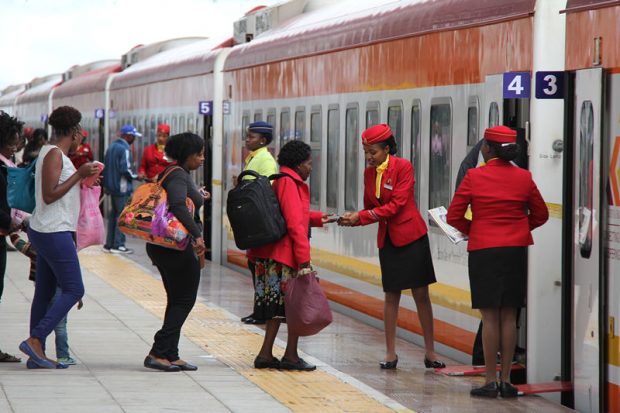
BRI draws a splendid picture of people-to-people bond

The 2nd Belt and Road Forum for International Cooperation (BRF) kicked off in Beijing on April 25. Nearly 5,000 participants from more than 150 countries and 90 international organizations gather at the three-day event to cement people-to-people bond and build splendid dreams. In the past 6 years, the Belt and Road Initiative (BRI) has been translated from an envisioned concept into real action and progress on the ground. This March, the Boten Tunnel of the China-Laos Railway was dug through, which marked key progress for the railway project. Many young people of Laos dressed up and posed for pictures at the construction site to witness this significant moment.
The villagers along the railway were also frequent visitors of the project site. They expressed their hope on an earlier operation of the railway, as the trains can bring their fruits and rubber to China and more countries. The railway, which carries the dream of the Lao people, is a result of the strategic alignment between China’s BRI and Laos’ strategy to convert from a landlocked country to a land-linked hub, and also a miniature of the BRI’s implementation to improve infrastructure and enhance the people-to-people bond. With the proposal of BRI initiative, the total trade volume between China and the BRI countries has exceeded $6 trillion, and the 82 cooperation parks jointly built by China and other participating countries have created nearly 300,000 jobs for local communities.
In addition, progress has been made in education cooperation, culture, tourism, and medical aid, bringing not only development opportunities, but also a sense of participation, a sense of gain, and happiness to the people. Friendship, which derives from close contact between the people, holds the key to sound state-to-state relations. During the implementation of BRI, China has always adhered to the livelihood-oriented international cooperation and is dedicated to building more and more projects to bring benefits to the people. BRI has created tangible welfare to the people of related countries.
Local people in Kyaukpyu, Myanmar were always unwilling to go out at night in the town used to be shrouded in darkness. Thanks to the China-Myanmar natural gas pipeline, Kyaukpyu is illuminated at night, and now the streets are lighted with lamps. The project has won high appraisal from local residents. From the operation of the Stung Russei Chrum hydropower station in Cambodia, the Belo Monte ultrahigh-voltage power project in Brazil, and the power projects in the China-Pakistan Economic Corridor, to the China-Thai Railway, the Jakarta-Bandung High Speed Rail, and the Belgrade-Budapest Railway that are under construction, the BRI projects are bringing benefits to more and more people. The construction of the Mombasa–Nairobi Standard Gauge Railway created over 40,000 jobs for Kenya. It was common to see young Africans lining up and looking for jobs at the industrial parks built and operated by Chinese enterprises in Africa. Thanks to the BRI and the China-Europe freight train, the Kazakh woman surnamed Anita who came to China to study Chinese met her other half and started her own e-commerce company. With the construction of a Chinese car factory in South Africa, an employee surnamed Patrick has become a skillful technical worker after receiving training from the Chinese side. The decent job enabled him and his family to move to a big house near the factory.
The BRI turns the dreams of the participating countries and their people into common aspiration and is making efforts to make these dreams come true and ensure the happiness of the people. That is why the BRI is receiving increasing global recognition. The initiative is welcomed by the Lao people who specifically composed a song for it.A female German driver has also made promotion pamphlets to spread the ideas of the BRI. The initiative is making a symphony of people-to-people bond along the Belt and Road routes. Ana Jovanovic is a Chinese teacher at the University of Belgrade, Serbia. When she was a college student, the Chinese language was still an unpopular major. But nowadays, the Chinese major is very much welcomed, and its recruitment is also expanding by times.
Not only in Serbia, today, learning Chinese and Chinese songs has become a fashion in many BRI countries. The “passion” for Chinese reflects the demand for economic and trade exchanges and is also a result of cultural exchanges. In the recent six years, cultural exchanges and activities have been held frequently along the Belt and Road, such as Silk Road cultural years, tourism years, art festivals, think tanks and dialogues. The frequent exchanges are drawing closer the hearts of the people, becoming a bridge that promotes their friendship. The exchanges are laying a solid foundation for the implementation of BRI.
As a Chinese old saying goes, good friends feel close even when they are thousands of miles apart. Earlier this year, the China Foundation for Poverty Alleviation launched an international campaign to deliver “care packages” to elementary and middle school students in the developing countries along the Belt and Road. Upon receiving a package, a Nepalese child said she wanted to visit China. Mountains and seas cannot separate the people if their hearts are closed. The Belt and Road is a road full of hope along which the world can reach a brighter future.
By Zhang Fan
(People’s Daily)


